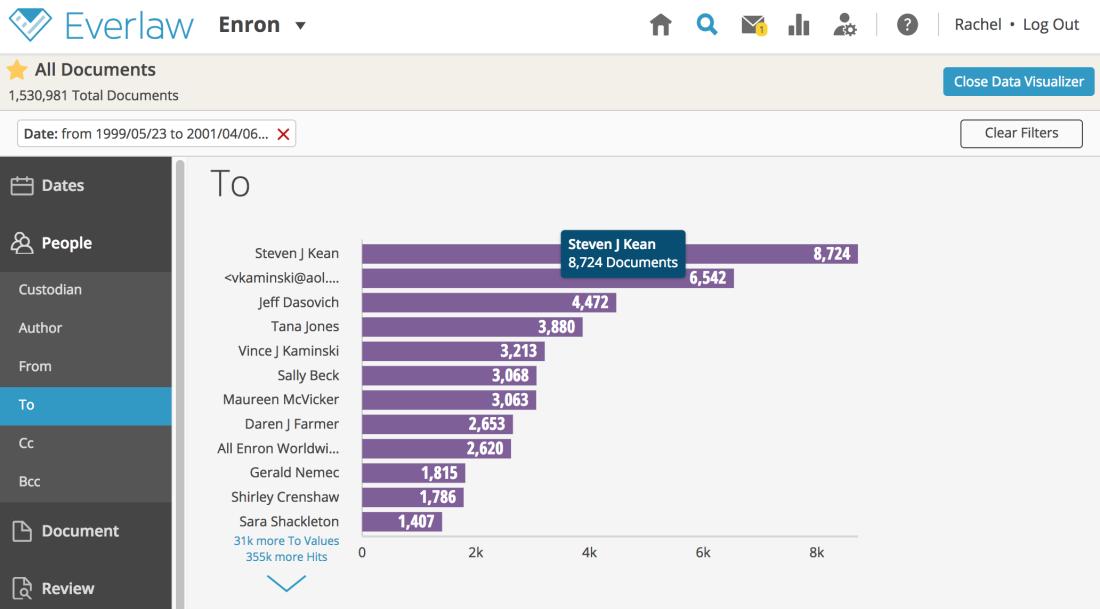Challenging Search Terms and Scope of Discovery with Data Visualization
by Everlaw

Data Visualization in Everlaw
Everlaw’s Data Visualizer provides an overview of the documents in your database by summarizing their characteristics visually. With Data Visualizer, you can explore documents at a glance without the need to review individual documents or predetermine a search. This is particularly useful in the context of early case assessment.
Data Visualizer can also help attorneys make more specific arguments about electronically stored information in a lawsuit. After providing attorneys an overview of their documents, attorneys can use filters to understand the documents at a glance. For example, an attorney might filter by custodian, by date range, or by file type, to better understand the dataset.
This information can be extremely helpful in preparing for a meet and confer with the opposing party, in developing a discovery plan, being ready to answer specific questions for a judge at a Rule 16 conference, or in preparing a proportionality argument in a discovery dispute.
Challenging the Judge’s Order
In litigation over the alleged denial of services under the Minnesota’s Medicaid Disability Waivers, the Defendants challenged the Magistrate Judge’s order on search terms and temporal scope of discovery. The District Court rejected the Defendants’ arguments that the Magistrate Judge’s were erroneous or contrary to law. Moreover, the proposed search terms and temporal scope were proportional to the needs of the case.
Here is what happened: The parties had a failed meet and confer over search terms after being ordered by Magistrate Judge Becky Thorson. The Plaintiffs’ search terms would have added another 70,000 records to review. The Defendant’s desired search terms would have resulted in 17,000 to review. Judge Thorson noted that given the issues in the lawsuit, having nearly 100,000 documents to review would not be a surprise. The Defendants challenged Judge Thorson’s order, claiming the Court did not adequately analyze proportionality and relevance with respect to the proposed search terms.
Judge Thorson’s ordered the temporal scope of discovery to cover January 1, 2009 to December 31, 2012. The Defendants challenged the relevancy of this time period and that the expanded scope would add another 2,619 documents to review.
District Judge Donovan Frank held that Judge Thorson’s order was not clearly erroneous or contrary to law. Judge Frank based his decision on the demonstrated relevance of each of Plaintiffs’ proposed search terms and the Defendant’s failure to adequately support her claimed burden in utilizing those search terms.
The Court also rejected the challenge to the scope of discovery going back to 2009, because of factual events supporting the Plaintiffs’ claims in the lawsuit. Moreover, the Defendants did not demonstrate that the information was irrelevant or responding would cause undue burden.
Proportionality Arguments with the Data Visualizer
Judges want proportionality to contain facts about the data at the center of motion practice. The above case includes broad numbers of documents for review—approximately 17,000 and 70,000 records. However, it’s difficult to know the value of these documents and the burden to review them without more information.
Using the above case as an example, the Data Visualizer could have provided both parties with more insight into the 70,000 search hits beyond a mere number. After running the search for the 70,000 hits, the data can be visually filtered based on metadata—such as specific email addresses or dates. Here are additional filters an attorney might make use of:
Metadata properties related to people (i.e. Author, To, From)
Document content (i.e. subject line and title)
Document characteristics (i.e. Bates prefix, doc type, application, format type)
Review activity (i.e. document rating, coding, binders)
Predicted relevance score for any prediction models
If the 70,000 documents from the above case had been in Everlaw, attorneys could interact with the metadata fields for To, From, or Document Type, as horizontal bars in the Data Visualizer. Clicking on the bars allows the attorney to apply additional filters to understand the relevance of the data.

Attorneys could zero in on emails from specific individuals to identify the number of records for each person. Attorneys could estimate how much of the data could be relevant to the case by applying a prediction filter to the data. Attorneys could also have visualizations based on the subject lines of emails, providing awareness on how much discussion took place on an issue.
[Screenshot of email from specific person with prediction model applied]
Argue Proportionality with Specifics
Data Visualization can give lawyers specific insight into their data in making a proportionality argument. Being able to go beyond stating the number of search hits empowers lawyers to provide estimates on the percentage of possible relevant information to review, which could be extrapolated to determine the amount of time to conduct document review. Moreover, providing Courts with detailed information on the number of emails and documents from specific individuals can help litigants decide who is relevant to a case against those who do not have information supporting the claims and defenses within a lawsuit. This level of detail can greatly assist judges in issuing discovery orders when parties have a dispute on what data is relevant to a lawsuit.

Everlaw’s advanced technology empowers organizations to navigate the increasingly complex ediscovery landscape, tackle the most pressing technological challenges, and chart a straighter path to the truth—transforming their approach to discovery, investigations, and litigation in the process.